Sportsman Electraflyer
- Thread starter sportscarpat
- Start date
I'm a neophyte when it comes to electrics but I was going to tell you in a PM to pay no attention to MBR. Its amprage and voltage that counts. Same volatage and higher amprage flow to the controler will get you to 45 MPH. Sustained ( if not for long given the size of your existing battery C rating ) PARTY ON PAT! YOU ROCK!
Everything you said is correct, except 'staying at 52V under full load'...it won't happen. Your new battery will also have some degree of sag, but probably (as you say) less than the one you are using for testing...which you will feel not only in terms of top speed, but also as acceleration, since it will sag less, therefore delivering more amps and volts in nearly all conditions...
The bike looks fantastic!
Is there a free wheel sprocket attached to the motor? If not, that might be a way to avoid having the motor turn over when you are pedalling...
Cheers,
Doug
The bike looks fantastic!
Is there a free wheel sprocket attached to the motor? If not, that might be a way to avoid having the motor turn over when you are pedalling...
Cheers,
Doug
Thanks, Velo. I appreciate that. Regardless of the messenger I need to make sure I don't pass along bad info.
Doug,
I said this before, your obviously experienced with electric bikes and your input has been appreciated. When working through the variables to determine gearing I needed a reasonably accurate h.p rating. With my gas bike experience I know approximately what gear ratio a given h.p. can push on my bikes. Looks like I was pretty close in this application but did not consider voltage drop off at full throttle. Is there a rule of thumb so to speak for the percent dropoff? Say 5% or 10% in a 52 volt system?
Doug,
I said this before, your obviously experienced with electric bikes and your input has been appreciated. When working through the variables to determine gearing I needed a reasonably accurate h.p rating. With my gas bike experience I know approximately what gear ratio a given h.p. can push on my bikes. Looks like I was pretty close in this application but did not consider voltage drop off at full throttle. Is there a rule of thumb so to speak for the percent dropoff? Say 5% or 10% in a 52 volt system?
Pat & Doug the dynamics of the components comprising the motor drive, battery, wiring and control system intrigue me, and the drop off of voltage at "full throttle" drives me to inquire if this voltage drop off is a factor of an individual component, regardless of quality, or corporately...all of the elements combined, leading to systemic voltage loss? If all factor into the loss, which of the elements contributes to the highest percentage of voltage drop? If it makes it easier to respond consider only using very high end components without exception.
Pat the videos had me laughing 'cause you were obviously having a blast and that little cycle will really scoot and does so with style. Rick C.
Pat the videos had me laughing 'cause you were obviously having a blast and that little cycle will really scoot and does so with style. Rick C.
Hi Rick,
What, me enjoy myself? Nah. Even when I do those burnouts there is a determined look on my face. All about the engineering. Actually I was trying hard not to laugh. My wife refused to video me doing a burnout. Told me I was acting like a little kid. I told her there is still a little kid in every guy I know and besides I need to do this for testing purposes.
Ever put a volt meter on a battery and crank a car over? You'll see voltage drop. The better the battery the less drop. That's how my brain puts it into perspective.
What, me enjoy myself? Nah. Even when I do those burnouts there is a determined look on my face. All about the engineering. Actually I was trying hard not to laugh. My wife refused to video me doing a burnout. Told me I was acting like a little kid. I told her there is still a little kid in every guy I know and besides I need to do this for testing purposes.
Ever put a volt meter on a battery and crank a car over? You'll see voltage drop. The better the battery the less drop. That's how my brain puts it into perspective.
Hi,Thanks, Velo. I appreciate that. Regardless of the messenger I need to make sure I don't pass along bad info.
Doug,
I said this before, your obviously experienced with electric bikes and your input has been appreciated. When working through the variables to determine gearing I needed a reasonably accurate h.p rating. With my gas bike experience I know approximately what gear ratio a given h.p. can push on my bikes. Looks like I was pretty close in this application but did not consider voltage drop off at full throttle. Is there a rule of thumb so to speak for the percent dropoff? Say 5% or 10% in a 52 volt system?
I am not sure a 'rule of thumb' is really possible, since there are so many variables:
- Exact cells used in the battery, and their characteristics;
- Series / parallel configuration of your particular battery;
- Age and condition of the battery;
- State of charge of the battery;
- Power usage curve of the particular motor used;
- wiring (too small a gauge anywhere in the path can add to sag);
- specific power application curve of the controller used;
- RPM of the motor at the moment the throttle is opened (greatest sag typically at lowest RPMs);
- load conditions (weight of bike / rider, slope, speed, rolling resistance);
...and probably a few others I have missed.
Working with 'HP' ratings with electric drive systems, although tempting because it is familiar, for all of the above reasons is really not that useful. If you want to use 'one measurement' for comparison purposes, watts is more useful, but needs to be considered / calculated for each of the different components / voltage / amps...
The bottom line, is this is simply how batteries of ALL types work, to varying degrees - voltage drops when load is applied.
Even the AC coming out of the wall in your home or business will sag under heavy load, like when a compressor or large electric motor first starts up - ever notice the lights will dim slightly, temporarily? That is sag.
Lithium cells in general are noted for having greater sag than most other battery chemistries; indeed this was a major obstacle to them being useful for motive applications in the early days of their existence.
At the end of the day, the greatest defence against sag, is more amp hours capacity in the battery, relative to the number of amps being drawn under full load.
All e-bike controllers suitable for use with lithium batteries, should have a programmable low voltage cut-off to protect the battery from discharging too much (this prolongs battery lifespan considerably).
If this voltage cut-off level is set too high, or if the battery amp hours are not enough for the application, OR if the battery is getting old and tired, or nearing the end of its current charge, sag can cause the voltage to dip low enough to activate this cutoff...abruptly cutting power to the motor, usually only under full throttle / high load. Depending on the controller, the 'ignition' might have to be cycled off and on again to restore operation, or it may simply resume, but cut out again under high load.
If you experience the above with a known good battery still holding plenty of charge, and the cut-off voltage is set correctly, the only remedies are a different battery with more amp hours, OR possibly programming the controller to provide less than full output when the throttle is fully turned, OR substituting a less powerful motor that draws less under full load, reducing sag.
I hope this is helpful, if not a direct answer to your question...
Cheers,
Doug
Hi Doug,
Thanks for the info. Nice to know that added amp hours is the best way to reduce voltage sag. My controller is currently set up for a 60 amp battery and not the 40 amp I am testing. Difference between the two in amp hours is 17.4 verses 28.3 I think. My motor should be matched well for the bigger battery. I'll just patiently wait (yeah, right!) for the bigger battery and in the mean time test within the limits of the battery I have.
Pat
Thanks for the info. Nice to know that added amp hours is the best way to reduce voltage sag. My controller is currently set up for a 60 amp battery and not the 40 amp I am testing. Difference between the two in amp hours is 17.4 verses 28.3 I think. My motor should be matched well for the bigger battery. I'll just patiently wait (yeah, right!) for the bigger battery and in the mean time test within the limits of the battery I have.
Pat
Hey Pat, Do you mind sharing some close-up photos of your modified car engine bike stands. Especially the top plate on the stand without a bike mounted and all the associated parts of it. I have two engine stands screaming at me to modify them!
I just chop off the top of the stand below the round tube where the car engine mount rotates, cap the rectangle tube, then weld a 1/2" nut to the cap plate. From there I add a piece of all-thread bottomed out in the nut, then cut a piece of flat bar to hold the bicycle frame in place. The stand will not work on a Schwinn with built in kickstand mount but works well for most all other frames.
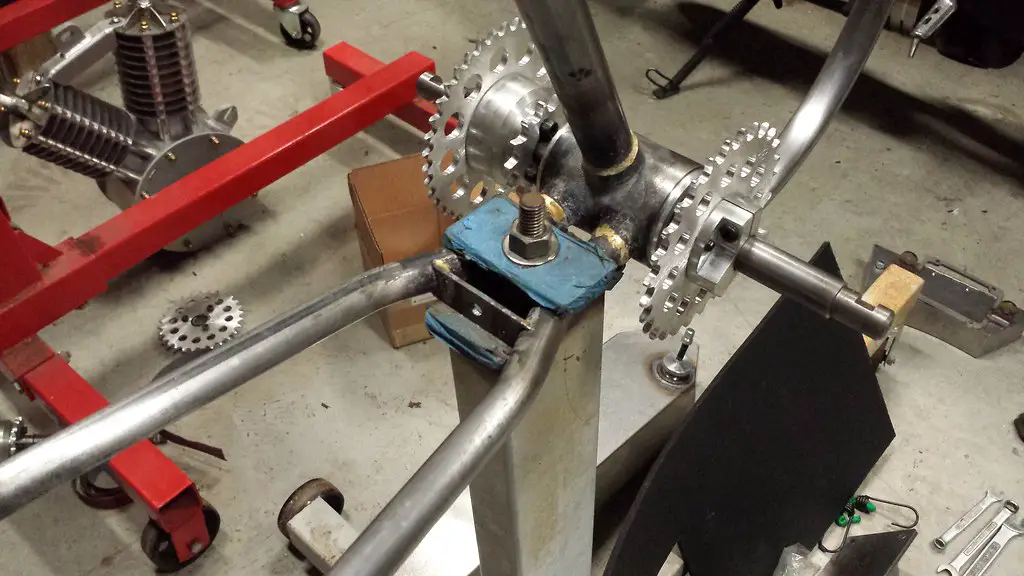 Build Stand by Pat Dolan, on Flickr
Build Stand by Pat Dolan, on Flickr
 Build Stand by Pat Dolan, on Flickr
Build Stand by Pat Dolan, on FlickrThanks Pat for the photo and explanation! Time to break out the saw-zaw and welder.I just chop off the top of the stand below the round tube where the car engine mount rotates, cap the rectangle tube, then weld a 1/2" nut to the cap plate. From there I add a piece of all-thread bottomed out in the nut, then cut a piece of flat bar to hold the bicycle frame in place. The stand will not work on a Schwinn with built in kickstand mount but works well for most all other frames.
More product testing today. Bike runs great. Totally reliable. I rode it for hours. The power level remains fairly constant. Never killed the battery, just rode and rode. It actually rides real nice, handles killer, really tight.
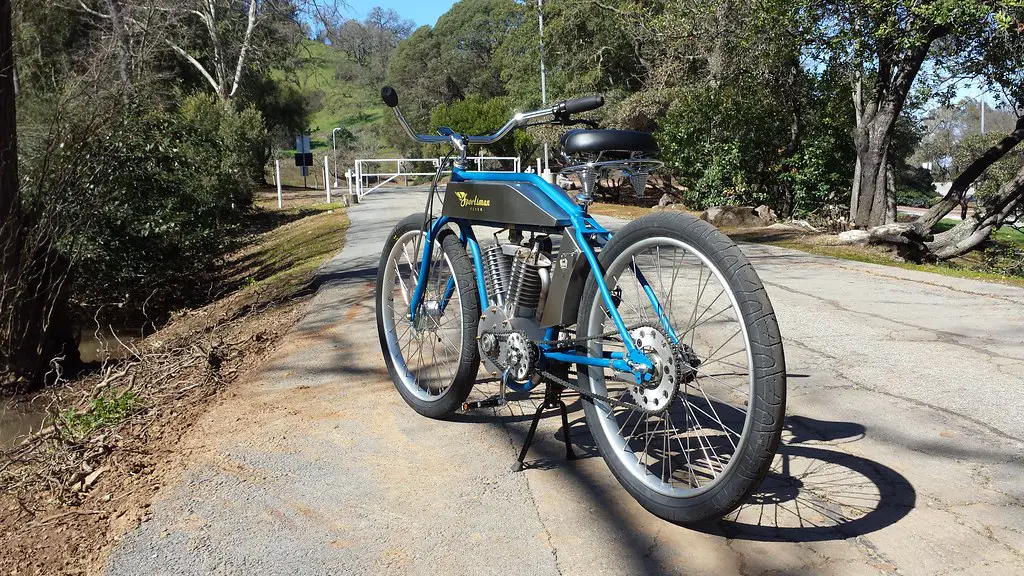 Sportsman Electraflyer by Pat Dolan, on Flickr
Sportsman Electraflyer by Pat Dolan, on Flickr
Bike is pretty light compared to a 200cc bike. The concept is proven. Time to build some more bikes......
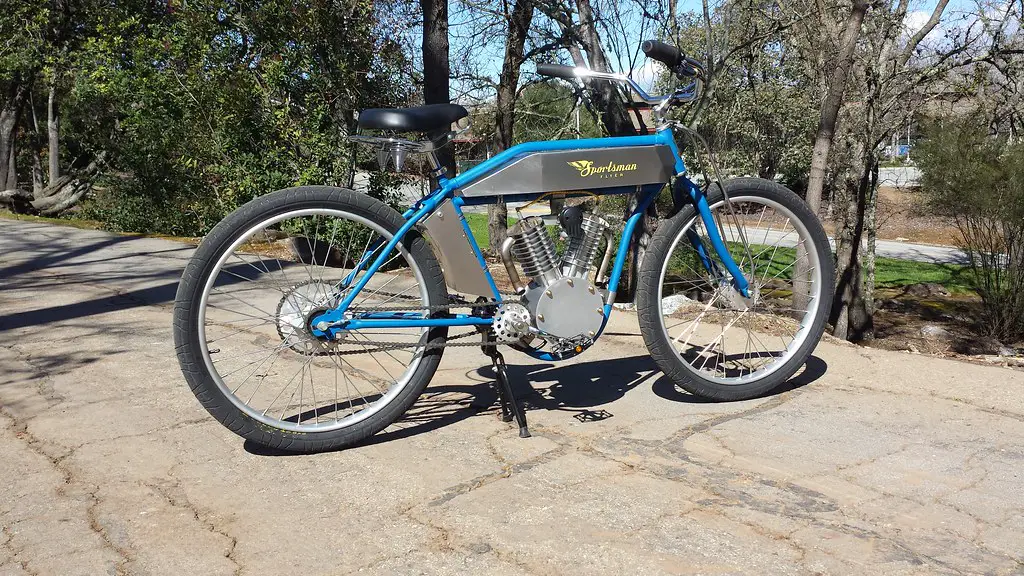 Sportsman Electraflyer by Pat Dolan, on Flickr
Sportsman Electraflyer by Pat Dolan, on Flickr
 Sportsman Electraflyer by Pat Dolan, on Flickr
Sportsman Electraflyer by Pat Dolan, on FlickrBike is pretty light compared to a 200cc bike. The concept is proven. Time to build some more bikes......
 Sportsman Electraflyer by Pat Dolan, on Flickr
Sportsman Electraflyer by Pat Dolan, on FlickrHere is where I'm going with this. The pictures didn't come out well, but you'll get the idea. Harley style forks from our Bonneville experience. Disc brakes front and rear. Nice big fat gas tank to hold the biggest batteries available. Same with the tool box for the controller.
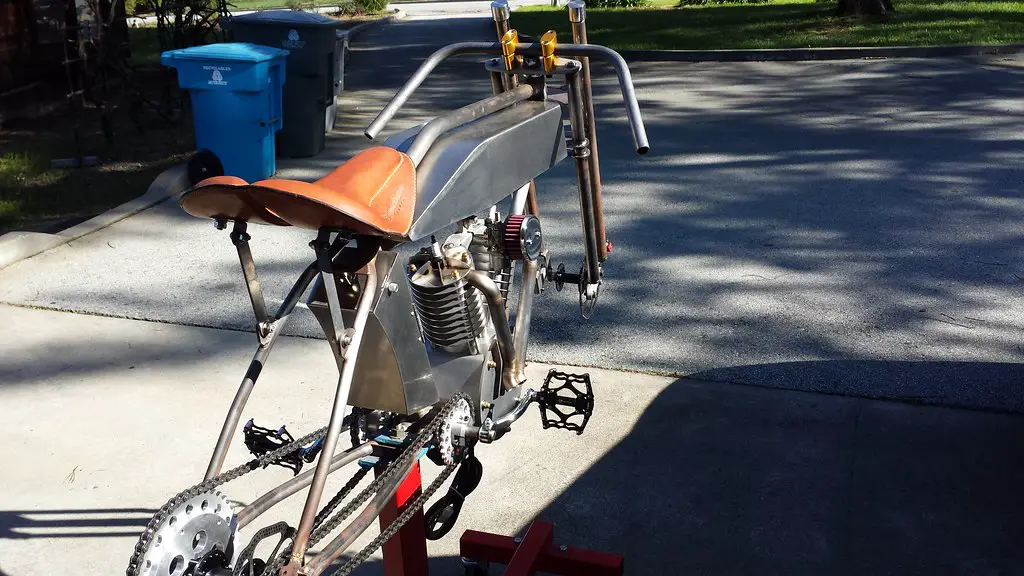 Sportsman Electraflyer by Pat Dolan, on Flickr
Sportsman Electraflyer by Pat Dolan, on Flickr
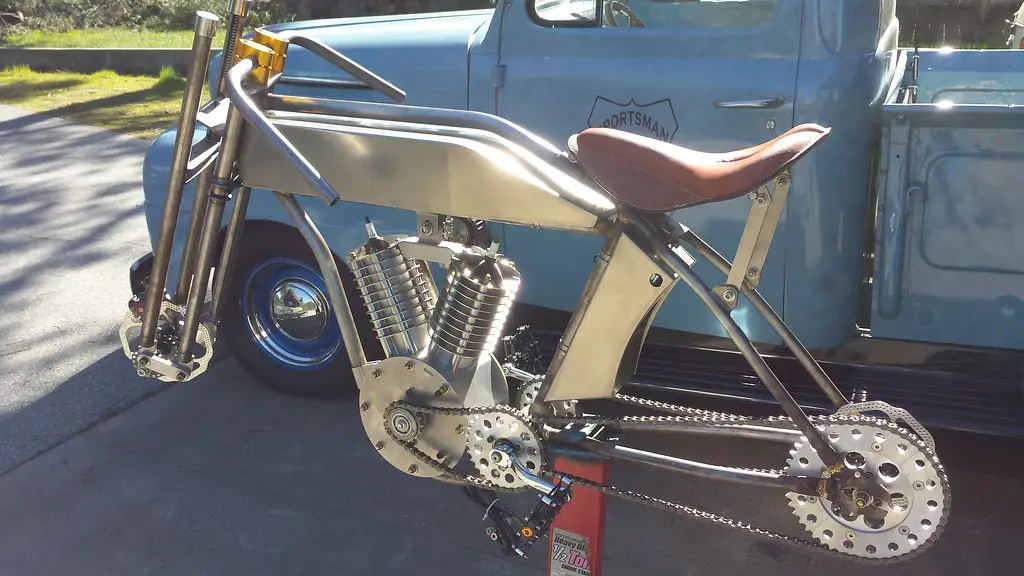 Sportsman Electraflyer by Pat Dolan, on Flickr
Sportsman Electraflyer by Pat Dolan, on Flickr
Right side of bike showing the disc brakes. 160mm rear and 180mm front. This will be a 72v bike geared for 50 mph. You can see the wire harness hanging out the bottom of the crank case.
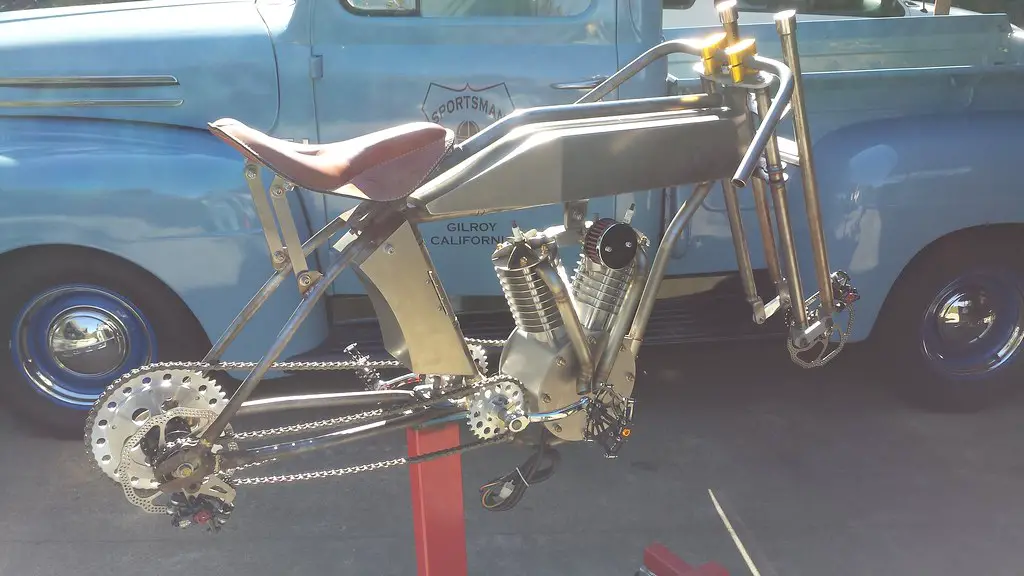 Sportsman Electraflyer by Pat Dolan, on Flickr
Sportsman Electraflyer by Pat Dolan, on Flickr
 Sportsman Electraflyer by Pat Dolan, on Flickr
Sportsman Electraflyer by Pat Dolan, on Flickr Sportsman Electraflyer by Pat Dolan, on Flickr
Sportsman Electraflyer by Pat Dolan, on FlickrRight side of bike showing the disc brakes. 160mm rear and 180mm front. This will be a 72v bike geared for 50 mph. You can see the wire harness hanging out the bottom of the crank case.
 Sportsman Electraflyer by Pat Dolan, on Flickr
Sportsman Electraflyer by Pat Dolan, on FlickrCongratulations Pat on the beautiful "test mule" completion and testing. I'm definitely in love with the board track bike, though only partially completed, it already stands out. I wish you great success as they are brought to market. Rick C.
I second that emotion!Looks AWESOME!!
Doug
The final battery has arrived safely to my shop and it's a beauty. The quality looks excellent. It was sourced from EM3EV and custom built to my application. It is basically 52v 30ah. My understanding is 30ah (amp hour) is quite a bit of capacity.
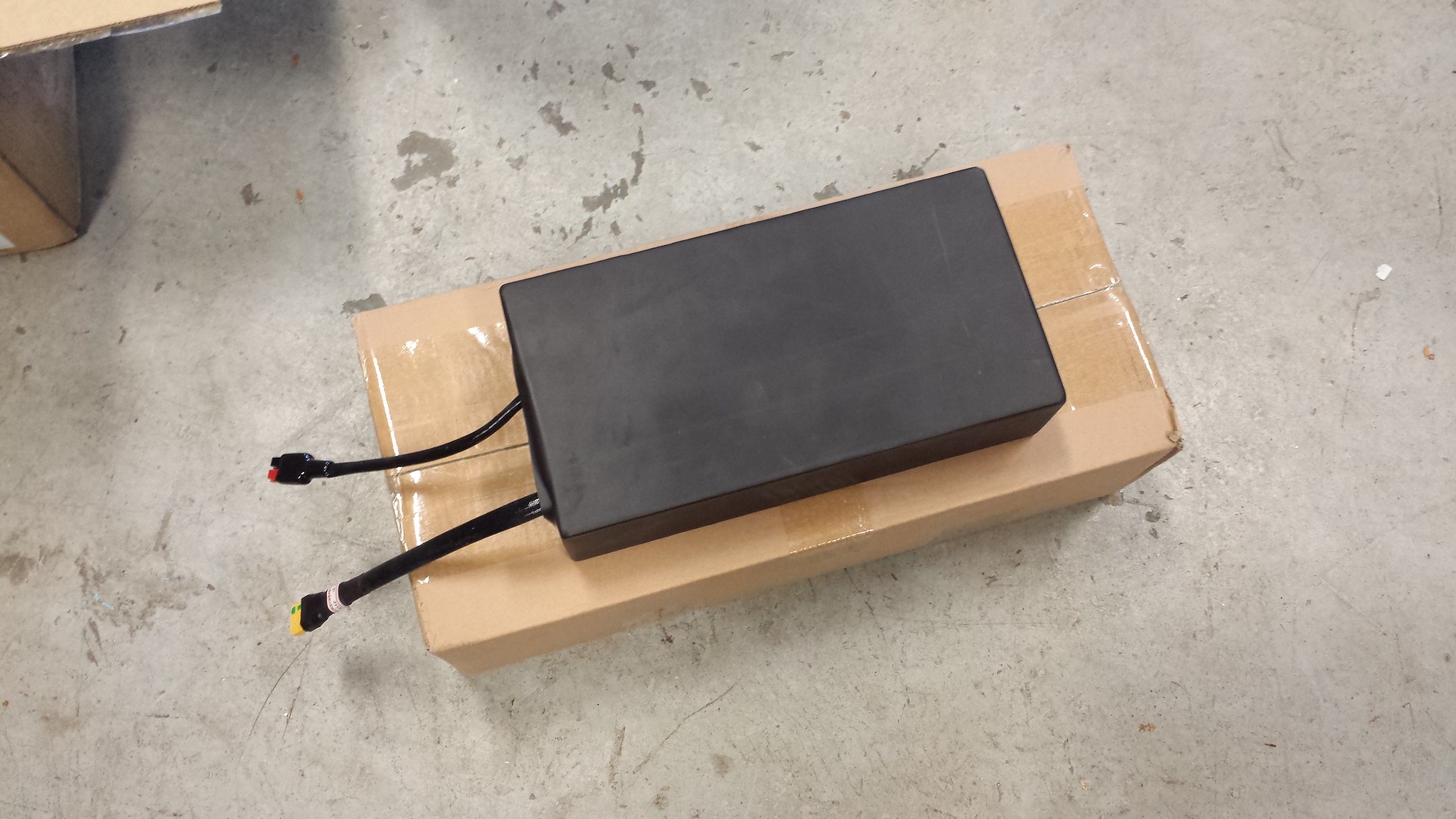 New Battery by Pat Dolan, on Flickr
New Battery by Pat Dolan, on Flickr
Old battery verses new.
 New Battery by Pat Dolan, on Flickr
New Battery by Pat Dolan, on Flickr
Battery fit into tank. I will follow up with riding impressions soon.
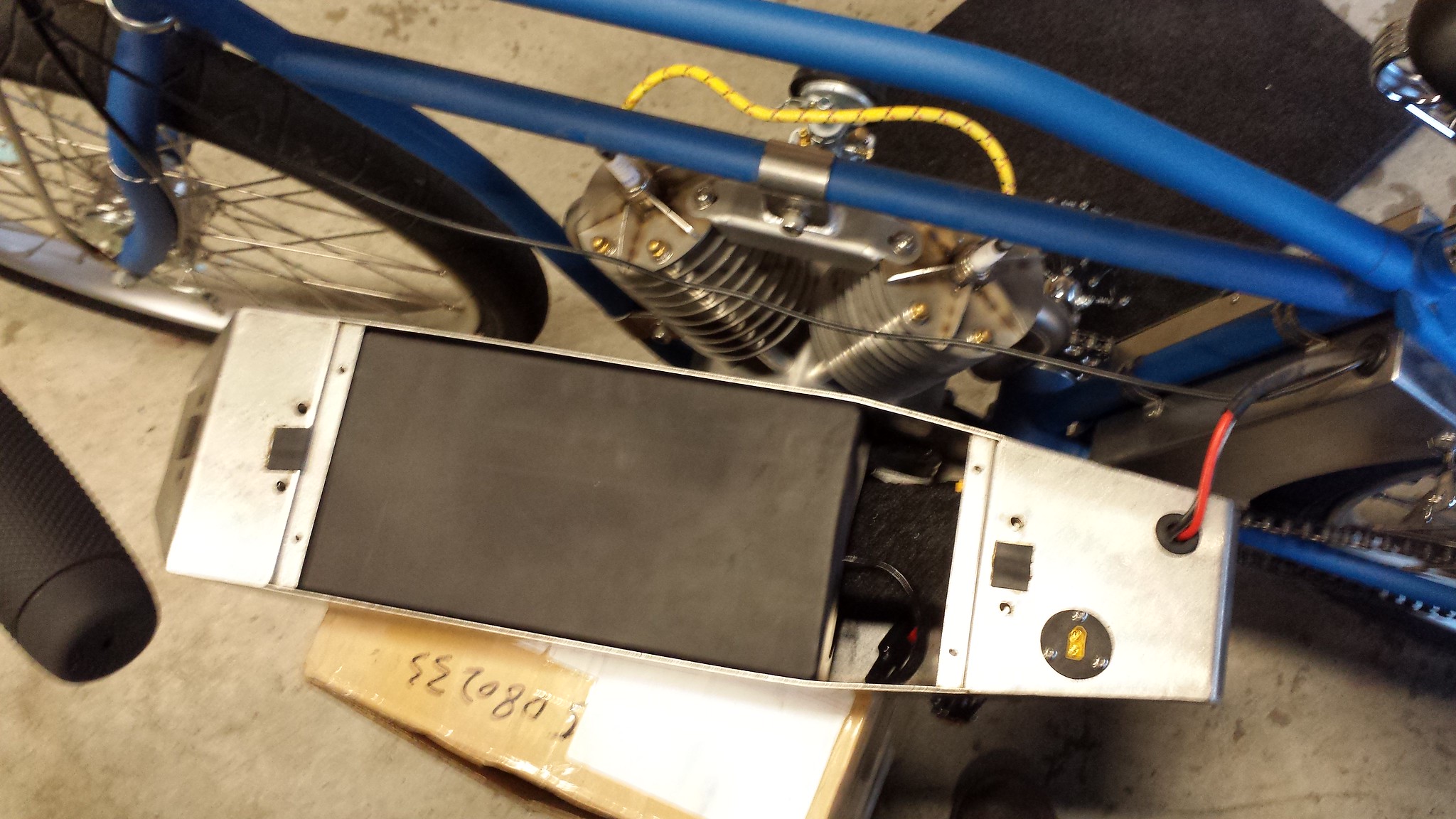 New Battery by Pat Dolan, on Flickr
New Battery by Pat Dolan, on Flickr
 New Battery by Pat Dolan, on Flickr
New Battery by Pat Dolan, on FlickrOld battery verses new.
 New Battery by Pat Dolan, on Flickr
New Battery by Pat Dolan, on FlickrBattery fit into tank. I will follow up with riding impressions soon.
 New Battery by Pat Dolan, on Flickr
New Battery by Pat Dolan, on FlickrPat that 30 amp battery fits so well inside the tank. I don't like the appearance of battery storage on most electric bikes or exposed mid drive motors either. You've come up with elegant vintage style solutions to conceal both. Before you started the Electra build my favorite "look" on electric bokes was the rear hub drive motor location and with the batteries in your style tank that would still be a good look, in M H O. (but not as good as your Electra setup). I can't wait for the next test ride battery update. Rick C.



